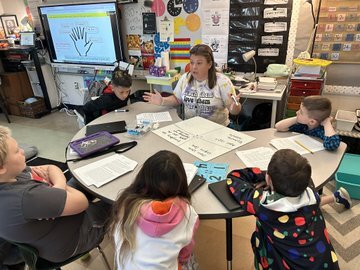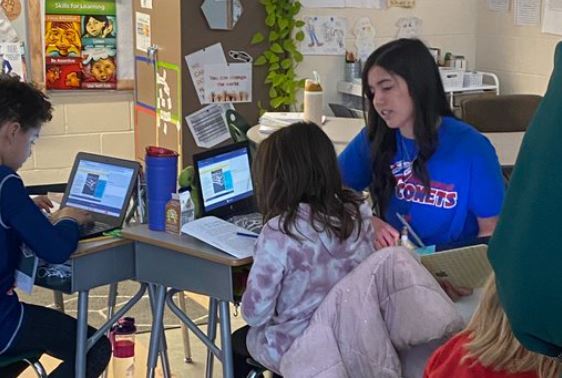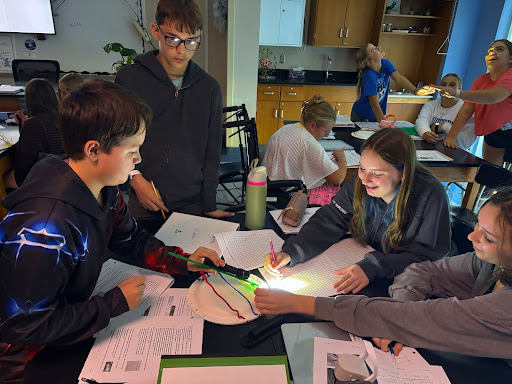
Kenton County Uses Systems and Structures to Support Teachers in Literacy Transformation
“A student’s ability to read is a critical predictor of success both in education and life. Our students must have the opportunity to gain and strengthen this skill, and our teachers have to be equipped and empowered in literacy instruction to best support their students, as we know that our teachers are the most important factor in student success. As a district, we are taking comprehensive actions to improve literacy outcomes for all students.”
– Shawna Harney, Chief Academic Officer, Kenton County School District
In the spring of 2022, Kenton County teachers and district administrators began noticing trends within their data. Although their literacy scores consistently surpassed state averages, a portion of their students were still not reaching desired levels of proficiency. According to the Kentucky Summative Assessment (KSA) for the 2021-2022 school year, only 59% of students in grades 3-5 were reading at or above the proficient level. This meant that 41% of students were falling behind, scoring Novice or Apprentice. At the same time, teachers noticed differences in foundational skills instruction across buildings and the district, creating inconsistent learning experiences for students. It was clear that change was necessary.
Kenton County’s Chief Academic Officer Shawna Harney, said, “Around the same time we were beginning our work, the stars aligned with the passing of Senate Bill 9 (2022). Our team was excited about this work and the changes that would come with it. We already had solid systems and structures to work with, allowing us to make changes to our literacy program without overwhelming our staff.”
The district’s first step was to focus on Tier 1 Instruction, guided by the Kentucky Department of Education’s Model Curriculum Framework. Harney says that this quote from the framework speaks to the heart of their district’s work:
“When schools and districts across the state develop and implement a coherent, high-quality curriculum grounded in the Kentucky Academic Standards, measure learning through a system of balanced assessment, and support teachers with high-quality instructional resources and evidence-based instructional practices, they provide a more equitable environment for all. As educators across a school or district work together to implement the local curriculum, it helps ensure each student has equal access to the same content, knowledge and/or skills regardless of teacher or school they attend.”
With this guiding principle, Kenton County embarked on identifying a comprehensive high-quality instructional resource (HQIR) for literacy. During the 2022-2023 school year, committees were formed involving stakeholders from each school to work through their instructional resource review process, score each resource using a rubric and recommend a resource for adoption. Harney emphasized the importance of supporting teachers, stating, “If we are about all kids, we also have to be about all staff.” Providing teachers with high-quality resources would free them from the burden of searching for materials, allowing them to focus on instruction. With this in mind, the Kenton County Board of Education approved a 5-year, comprehensive instructional resource plan to ensure this work was sustainable.

To establish a unified vision, Kenton County introduced the Kenton County School District (KCSD) literacy shifts to elementary principals and created kickoff videos for each initial resource training. A variety of training sessions were offered, including initial resource training for K-5 and 6-12 teachers, Science of Reading for Beginners for all employees, and Integrating the Arts into Literacy for elementary elective teachers.

The district also established systems of support. A phonics committee of teachers was created to develop a common scope and sequence for instruction. The district also formed a literacy committee, which meets monthly to review data and identify areas for growth. Additionally, academic program consultants, who serve as district-level instructional coaches, supported schools and teachers in this endeavor.
Literacy leader positions were created within each school to further support the district literacy initiatives. Teachers were selected to receive a stipend for attending district trainings and disseminating information. They led literacy initiatives within their schools and worked to enhance overall staff capacity. They also provided individual literacy support and collaborated with school administration to facilitate job-embedded professional learning focused on literacy instruction.

As part of its professional learning plan, Kenton County also made a large investment in supporting teachers who completed the Kentucky Reading Academies LETRS Professional Learning opportunity. Kenton County had 89 teachers and staff who participated in Cohorts 1 and 2 of LETRS, each receiving a stipend for their time and efforts. Harney says, “The LETRS participants in our district are having a meaningful and impactful experience because they have a resource that is aligned to their learning and, thus, resulting in commitment to implementation of the HQIR versus compliance.”
During implementation of the new HQIR, Kenton County not only focused on using the resource with fidelity, but also on what they knew about best practices for quality instruction. In order to ensure students had access to both, KCSD implemented fidelity walks. The district academic program consultants joined school administrators for walkthroughs in buildings. They used the resource’s fidelity markers along with their KCSD Cycle of Quality Instruction elements. As a result of these walks, both teachers and administrators received feedback, and the district was able to gain a big picture look at the implementation of the new resource. Initial data from the district’s universal diagnostic assessment indicated that schools and grades with higher fidelity levels saw better student outcomes, with the most substantial improvements seen in grades K-3.

Teachers in Kenton County also felt the impact of their LETRS training during the implementation of their new HQIR. Amanda Grimes, third-grade teacher at River Ridge Elementary, says, “Having background knowledge from LETRS greatly impacted my experience with implementing Core Knowledge Language Arts (CKLA). LETRS allowed me to better understand the theories and research (the why) of the program. The overall structure of the CKLA program is aligned around the science of reading from its tiered vocabulary instruction to the query-based instruction during read aloud, and many other concepts that I was familiar with because they were taught in LETRS. I was able to use my learning from LETRS and apply it directly to my instruction through CKLA lessons.”
As they move forward, Harney and the Kenton County team are committed to building upon their first year of implementation and refining their systems and structures. They will continue to use the Kentucky Department of Education’s Curriculum-Based Professional Learning guidance document to self-assess, adjust and guide their work. Harney remains optimistic yet realistic saying, “We know that our data won’t change overnight, but we will be patient, celebrate progress and continue to be motivated by the data and successes we do see.”



